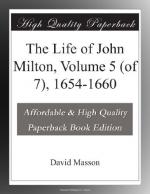the Resolutioners the Tories, of Scotland through
that time; and the strife between the parties was
all the fiercer because, Scottish autonomy being lost,
it was the only native strife left for Scotsmen, and
they were battened down to it, as an indulgence among
themselves, by a larger and unconcerned rule overhead.
General Assemblies of the Kirk being no longer allowed,
it had to be conducted in Provincial Synods and Presbyteries
only, or in sermons and pamphlets of mutual reproach.
The exasperation was great; Church-censures and threats
of such passed and repassed; all attempts at agreement
failed; the best friends were parted. Leaders
among the majority, or Resolutioner clergy, were Mr.
Robert Douglas of Edinburgh, who had preached the
coronation sermon of Charles II. at Scone, Mr. James
Sharp of Crail (these two back for some time from
the imprisonment in London to which Monk had sent
them in 1651: Vol. IV. 296), Mr. James Wood
of St. Andrews, old Mr. David Dickson, now Professor
of Divinity in Edinburgh, and our perpetual friend
Baillie. The minority, or Protesters, were led
by such ministers as Mr. James Guthrie of Stirling,
their first oracle, Mr. Patrick Giliespie of Glasgow
University, Mr. John Livingston of Ancram, Mr, Samuel
Rutherford of St. Andrews, and Mr. Andrew Cant of
Aberdeen; with whom, as their best lay head, was Johnstone
of Warriston. Peace-makers, such as Mr. Robert
Blair of St. Andrews and Mr. James Durham of Glasgow,
negociated between the two sides; and Mr. Robert Leighton,
in his Edinburgh Principalship, looked on with saintly
and philosophic indifference. He hoped that,
while so many brethren “preached to the times,”
one brother might be allowed “to preach on eternity”
and that the differences on earth would “make
heaven the sweeter.” In fact, however,
the controversy was not merely a theoretical one.
Not only was it involved whether the two last General
Assemblies, of 1651 and 1652, swayed as they had been
by the Resolutioners, should be recognised and their
acts held valid, and what should be the spirit and
constitution of the Kirk in future: present interests
were also involved. It had been to the Protesters
that Cromwell had turned with greatest liking and
hope, both on political grounds and from spiritual
sympathy, when he was fighting in Scotland; and, since
the beginning of his Protectorate, they had
been most in favour. Early in 1654 three of their
number, Mr. Patrick Gillespie, Mr. John Livingston,
and Mr. John Menzies, had been summoned to London to
advise the Protector; they had been there two or three
months; and the effects of their advice had been visible
in an ordinance about vacant Kirk-livings very favourable
to the Protesters, and generally in a continued inclination
towards the Protesters in the proceedings of the English
Government in Scotland. The ministers and others
ejected by Cromwell’s visitors had been mostly
of the Resolutioner species; and one of Baillie’s
complaints is that Protesters, whether fit or not,
were put into vacant livings by the English, and that
only Scotsmen of that colour were conjoined with the
English in the executive and the judicatories.
Till 1656 all this had been very natural. The
dregs of Stuartism, and consequent antipathy to the
Protectorate, had persisted till then most visibly
among the Resolutioners.[1]




